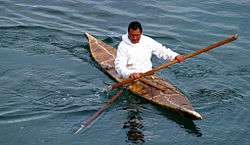Greenlandic Inuit
|
Greenlandic Inuit man hunting seals in a kayak, Kulusuk, Greenland, 2006 | |
| Total population | |
|---|---|
| (51,349 (2012)[1]) | |
| Regions with significant populations | |
| ≈51,000[2] | |
| ≈20,000[3] | |
| Languages | |
| Greenlandic Inuit language and Danish[1][4] | |
| Religion | |
| Inuit religion, Evangelical Lutheran[1] | |
| Related ethnic groups | |
| other Inuit peoples | |
Greenlandic Inuit are the indigenous peoples of Greenland. Approximately 89% of Greenland's population of 57,695 is Inuit or 51,349 people as of 2012.[1] Ethnographically, they consist of three major groups:
- Kalaallit of west Greenland, who speak Kalaallisut
- Tunumiit of east Greenland, who speak Tunumiisut
- Inughuit of north Greenland, who speak Inuktun or Polar Eskimo
Historically, Kalaallit referred specifically to the people of Western Greenland. Northern and Eastern Greenlanders call themselves Avanersuarmiut and Tunumiit, respectively.[5]
Today, most Greenlanders speak standard Greenlandic, and most are still descended from the original founding ancestors of Greenland. The other Greenlanders are mostly European migrants. There are few Greenlanders who are mixed racial origin and most of this is due to Danish colonists and other Europeans marrying into Inuit peoples. About 90% live in the southwestern corner of the island. Several thousand Greenlanders reside in Denmark proper.
Regions
Greenlandic Inuit people are considered to be descended from Dorset and Thule people, who settled Greenland in ancient times. As 84% of Greenland's land mass is covered by the Greenland ice sheet, Inuit people live in three regions: Polar, Eastern, and Western. In the 1850s, additional Canadian Inuit joined the Polar Inuit communities.[6]
The Eastern Inuit, or Tunumiit, live in the area with the mildest climate, a territory called Tasiilaq. Hunters can hunt marine mammals from kayaks throughout the year.[6]
Language


The Greenlandic Inuktitut language, along with Danish, are the national languages of Greenland.[1] It is an Eskimo-Aleut language and one of the Inuit languages, with three distinct dialects: Kalaallisut (West Greenlandic), Tunumiit (East Greenlandic), and Inuktun (Polar Eskimo, North Greenlandic, Thule Inuit).[4] The Inuktitut language is taught in schools and used widely in Greenlandic media.
History
Humans are thought to have arrived in Greenland, possibly from Ellesmere Island, around 3000–2500 BCE. Other researchers believe the first humans in Greenland were the Saqqaq people that migrated to western Greenland from the Canadian Arctic around 2500 BCE. Saqqaq people are unrelated to contemporary Greenlandic Inuit people. They survived until 800 BCE.[7]
Around 1000 BCE, people from the Dorset people settled in Greenland. Dorset people flourished in Greenland from 600 BCE to 200 CE. The Thule people began colonizing Greenland from the northwest in about 900 CE. Norse colonization of the island began in 982 CE and lasted a few centuries. Denmark-Norway passively maintained a claim to Greenland until 1721, when it resumed possession of the territory. In 1814, possession was awarded to Denmark by the Treaty of Kiel. In 1979, the Greenlanders voted to become autonomous. There is an active independence movement.
Society
Gender roles among Greenlandic Inuit are flexible; however, traditionally men hunt and women prepare the meat and skins. Most marriages are by choice, as opposed to arranged, and monogamy is commonplace. Extended families are extremely important to Inuit society.[8]
Art
The Greenlandic Inuit have a strong artistic tradition based on sewing animal skins and making masks. They are also known for an art form of figures called tupilaq or "evil spirit objects." Traditional art-making practices thrive in the Ammassalik.[9] Sperm whale ivory remains a valued medium for carving.[10]
Ammassalik wooden maps are exquisitely carved maps of the Greenlandic coastline, used in the late 19th century.
See also
Notes
- 1 2 3 4 5 "Greenland." CIA World Factbook. Retrieved 6 Aug 2012.
- ↑ "Grønlands Statistik". Stat.gl. Retrieved 2015-10-25.
- ↑ "Inuit Greenlanders face chilly life in Denmark". The Christian Science Monitor. Retrieved 2013-01-31.
- 1 2 "Inuktitut, Greenlandic." Ethnologue. Retrieved 6 Aug 2012.
- ↑ Baldacchino, Geoffery. "Extreme tourism: lessons from the world's cold water islands", Elsevier Science, 2006: 101. (retrieved through Google Books) ISBN 978-0-08-044656-1.
- 1 2 Hessel 11
- ↑ "Arctic Pioneers and Materiality: Studies of Long Term Trends in Saqqaq Material Culture, 2.500 BC — 800 BC." Smithsonian Museum of Natural History. 26 Oct 2012. Retrieved 14 Feb 2013.
- ↑ "Greenland." Countries and Their Cultures. Retrieved 6 Aug 2012.
- ↑ Ingo 20
- ↑ Hessel, 21
References
- Hessel, Ingo. Arctic Spirit. Vancouver: Douglas and McIntyre, 2006 ISBN 978-1-55365-189-5
External links
| Wikimedia Commons has media related to Greenlandic Inuit people. |
- Inuit Circumpolar Council: Greenland
- Culture and History of Greenland, Greenland Guide
- Colonialism in Greenland: An Inuit Perspective
| ||||||||||||||||||||||||||||||||||||||||||||||||||

